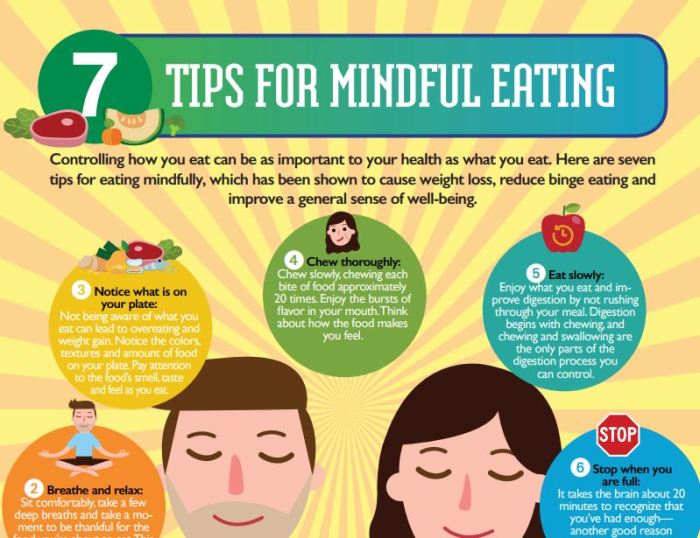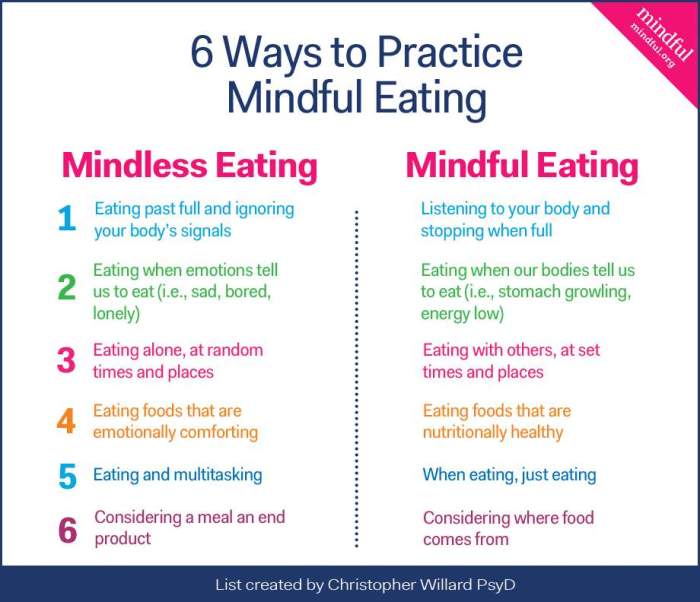Mindful Eating Practices: A Guide to Healthier Habits

Mindful eating practices are a powerful tool for improving our relationship with food and our overall well-being. This approach goes beyond simply consuming calories; it encourages us to savor each bite, connect with our bodies, and make conscious choices about what we eat.
By cultivating mindful eating habits, we can experience a deeper connection with our food, enhance our physical health, and foster a greater sense of emotional balance.
This guide delves into the core principles of mindful eating, exploring practical strategies for cultivating mindful eating habits and offering techniques to enhance your experience. We’ll also address common challenges and guide integrating mindful eating into your everyday life.
Mindful Eating Basics

Mindful eating is a practice that encourages us to pay full attention to our eating experiences, without judgment. It’s about connecting with our food, our bodies, and our emotions consciously and presently. By slowing down and savoring each bite, we can cultivate a more positive relationship with food and our bodies.
The Five Senses and Mindful Eating
The five senses play a crucial role in mindful eating. Engaging all of them enhances our awareness of the food we consume, making each bite a more enriching experience.
- Sight: Observe the color, shape, and texture of your food. Notice how light reflects off its surface and how it changes as you cut or break it apart.
- Smell: Inhale the aroma of your food. Notice the intensity of the scent, whether it’s subtle or strong, and how it evolves as you bring the food closer to your nose.
- Sound: Listen to the sounds your food makes as you chew, cut, or break it. Notice the crunch of a crisp apple, the sizzle of a steak, or the gentle rustle of a salad.
- Taste: Pay close attention to the flavors of your food. Notice the sweet, sour, salty, bitter, and umami notes. Observe how these flavors change as you chew and how they interact with one another.
- Touch: Feel the texture of your food with your fingers and your mouth. Notice its temperature, whether it’s soft, firm, smooth, or rough.
Benefits of Mindful Eating
Mindful eating offers numerous benefits, encompassing physical, emotional, and mental well-being.
- Improved Physical Health: By paying attention to hunger and fullness cues, mindful eating can help regulate appetite and prevent overeating, contributing to a healthy weight. It can also promote better digestion and nutrient absorption.
- Enhanced Emotional Well-being: Mindful eating fosters a more positive relationship with food, reducing emotional eating triggered by stress, boredom, or sadness. It also promotes self-awareness and acceptance of our bodies.
- Increased Mental Clarity: By focusing on the present moment, mindful eating can reduce stress and anxiety, leading to increased mental clarity and a sense of calm.
Cultivating Mindful Eating Habits: Mindful Eating Practices

Mindful eating is not just about what you eat but also how you eat. It involves paying attention to your food and your body’s signals, allowing you to enjoy your meals fully and make healthier choices. Cultivating mindful eating habits takes practice and patience, but the rewards are well worth the effort.
Practical Strategies for Cultivating Mindful Eating Habits
To develop mindful eating habits, it’s essential to incorporate practical strategies into your daily routine. These strategies can help you become more aware of your eating patterns and make conscious choices about your food.
- Eat without distractions: Turn off the TV, put away your phone, and focus solely on your meal. Engage all your senses – the sight, smell, taste, and texture of your food. This allows you to appreciate the flavors and textures more fully.
- Eat slowly: Take small bites and chew thoroughly. This allows your body time to register fullness and prevents overeating. Aim to savor each bite and enjoy the experience of eating.
- Listen to your body’s hunger and fullness cues: Pay attention to your body’s signals before, during, and after eating. Eat when you are truly hungry and stop when you feel comfortably full. Avoid eating out of boredom, stress, or emotional triggers.
- Practice gratitude: Before each meal, take a moment to appreciate the food you are about to eat and the people who have made it possible. This can help you cultivate a sense of thankfulness and enhance your enjoyment of the meal.
- Mindful snacking: If you find yourself snacking between meals, choose healthy options and practice mindful eating principles. Pay attention to your hunger cues and savor the flavors of your snacks. Avoid mindless snacking in front of the TV or computer.
Sample Meal Plan Incorporating Mindful Eating Principles
A mindful eating meal plan emphasizes quality over quantity, focusing on nutrient-rich foods and portion control. Here’s a sample meal plan that incorporates mindful eating principles:
- Breakfast: A bowl of oatmeal with berries and nuts. This provides a good source of fiber, protein, and healthy fats, keeping you feeling full and satisfied until lunch.
- Lunch: A salad with grilled chicken or fish, mixed greens, vegetables, and a light vinaigrette dressing. This provides a balanced meal with lean protein, fiber, and healthy fats.
- Dinner: Baked salmon with roasted vegetables and a side of quinoa. This provides a protein-rich meal with complex carbohydrates and healthy fats, promoting satiety and supporting healthy blood sugar levels.
- Snacks: Fruits, vegetables, nuts, or yogurt. These snacks provide healthy nutrients and help prevent overeating between meals.
Creating a Mindful Eating Environment
Creating a mindful eating environment can significantly impact your eating habits. It involves setting the stage for mindful eating by creating a calm and inviting space.
- Choose a designated dining area: This could be a table in your kitchen, a dining room, or even a cozy corner in your living room. Avoid eating in front of the TV or computer, as this can lead to mindless eating.
- Set the table: Use real plates and cutlery instead of paper or plastic. This creates a more intentional and enjoyable dining experience.
- Dim the lights: Soft lighting can create a relaxing atmosphere and enhance your appreciation for the food. This helps you focus on the experience of eating and avoid distractions.
- Play calming music: Soothing music can help create a peaceful and relaxing atmosphere, promoting mindful eating.
Mindful Eating Techniques

Mindful eating techniques involve focusing your attention on the present moment while consuming food. This approach encourages you to savor each bite, appreciate the flavors, and understand your body’s hunger and fullness cues. By practicing these techniques, you can enhance your relationship with food, improve your eating habits, and ultimately achieve a healthier lifestyle.
Guided Meditation for Mindful Eating
Guided meditation can be a powerful tool for cultivating mindfulness during meals. It involves focusing your attention on your breath, body sensations, and the experience of eating.
- Find a comfortable and quiet space where you can sit or lie down. Close your eyes and take a few deep breaths, allowing your body to relax.
- Bring your attention to your breath. Notice the rise and fall of your chest and abdomen as you inhale and exhale. Observe the sensation of the air entering and leaving your nostrils.
- Shift your focus to your body. Scan your body from head to toe, noticing any sensations you experience, such as warmth, tingling, or pressure. Pay particular attention to your stomach and digestive system.
- Bring your attention to the food you are about to eat. Observe its color, shape, texture, and aroma. Imagine the flavors you are about to experience.
- Take a small bite of your food and chew slowly, savoring each mouthful. Notice the different flavors and textures. Pay attention to the sensations in your mouth and the way the food feels as you swallow.
- Continue to eat mindfully, paying attention to your body’s signals of hunger and fullness. Notice how your body feels after each bite and whether you are still hungry or satisfied.
- When you finish eating, take a moment to reflect on your experience. Notice any thoughts or feelings that arose during the meal. Appreciate the nourishment the food provides.
Step-by-Step Guide for Mindful Eating
Mindful eating during a meal involves paying attention to the experience of eating in a non-judgmental way. This approach can help you develop a healthier relationship with food and avoid overeating.
- Choose a quiet and comfortable space where you can eat without distractions. Turn off the television, put away your phone, and create a peaceful environment.
- Before you start eating, take a few deep breaths and focus on your body. Notice any sensations of hunger or fullness.
- Observe your food. Take a moment to appreciate its appearance, color, texture, and aroma. Imagine the flavors you are about to experience.
- Take a small bite of your food and chew it slowly, savoring each mouthful. Pay attention to the different flavors, textures, and sensations in your mouth.
- Put your fork or spoon down between bites. This allows you to savor the food and become more aware of your body’s signals of fullness.
- Notice how your body feels after each bite. Are you still hungry or are you starting to feel satisfied? Pay attention to your body’s cues.
- Continue eating mindfully, savoring each bite, and paying attention to your body’s signals. Avoid distractions and focus on the experience of eating.
- When you finish eating, take a moment to reflect on your experience. Notice how you feel physically and emotionally. Appreciate the nourishment the food provides.
Mindful Eating Practices vs. Traditional Eating Habits
| Mindful Eating Practices | Traditional Eating Habits |
|---|---|
| Eating slowly and savoring each bite | Eating quickly and rushing through meals |
| Paying attention to hunger and fullness cues | Ignoring hunger and fullness cues |
| Eating in a quiet and distraction-free environment | Eating while watching television or working |
| Choosing foods that are nourishing and satisfying | Choosing foods that are convenient or unhealthy |
| Focusing on the present moment and enjoying the experience of eating | Thinking about other things or multitasking while eating |
Overcoming Challenges

Mindful eating, while beneficial, can present challenges. These obstacles are common and can be overcome with consistent effort and effective strategies.
Overcoming Emotional Eating and Food Cravings, Mindful eating practices
Emotional eating, often triggered by stress, boredom, or sadness, can disrupt mindful eating practices. Food cravings, driven by biological and psychological factors, can also pose challenges. Here are strategies to manage these issues:
- Identify Triggers: Keeping a food journal can help identify patterns in emotional eating and cravings. This journal can track emotions, situations, and food choices, revealing triggers that lead to unhealthy eating habits.
- Develop Healthy Coping Mechanisms: Instead of turning to food, find alternative ways to manage stress and emotions. Engage in activities like exercise, meditation, spending time in nature, or connecting with loved ones.
- Practice Delay Tactics: When cravings strike, delay gratification by engaging in a distracting activity for 15-20 minutes. This can help reduce the intensity of the craving.
- Mindful Eating Practices: Paying attention to hunger cues and satiety signals can help distinguish between real hunger and emotional cravings. Focus on the sensory experience of eating, savoring flavors, and enjoying the food.
Managing Stress and Anxiety Related to Food
Stress and anxiety can significantly impact eating habits. The constant worry about food choices, calorie intake, or body image can create a vicious cycle of anxiety and unhealthy eating. Here are some ways to manage stress and anxiety related to food:
- Seek Professional Help: If stress and anxiety related to food are overwhelming, consider seeking professional help from a therapist or registered dietitian. They can provide guidance and support in developing healthy coping mechanisms.
- Practice Mindfulness: Mindfulness techniques, such as meditation or deep breathing exercises, can help calm the mind and reduce stress. These practices promote self-awareness and acceptance, fostering a more positive relationship with food.
- Challenge Negative Thoughts: Recognize and challenge negative thoughts about food and body image. Replace these thoughts with positive affirmations that promote self-compassion and acceptance.
- Focus on Nourishment: Shift your focus from restrictive diets to nourishing your body with healthy and wholesome foods. This approach emphasizes the enjoyment of food for its nutritional value and overall well-being.
Mindful Eating in Everyday Life
Mindful eating is not just a practice for special occasions or mealtimes; it can be seamlessly integrated into your daily routines. By bringing awareness to your eating habits, you can transform your relationship with food and experience a more fulfilling and healthier lifestyle.
Real-Life Examples of Mindful Eating
Mindful eating has a profound impact on individuals, leading to a variety of positive outcomes. For example, a study published in the journal “Appetite” found that mindful eating interventions led to significant reductions in binge eating and emotional eating behaviors.
This demonstrates the power of mindful eating in promoting healthy eating habits and improving overall well-being.
Incorporating Mindful Eating into Daily Life
Mindful eating practices can be incorporated into various aspects of your daily life, from meal preparation to snacking and social gatherings. Here’s a simple checklist to guide you:
Meal Preparation
- Choose fresh, whole foods whenever possible.
- Pay attention to the colors, textures, and aromas of your food.
- Cook with intention, savoring the process of creating a nourishing meal.
Mealtimes
- Create a peaceful and inviting dining environment.
- Turn off distractions like phones and television.
- Take small bites and chew your food thoroughly.
- Pay attention to the flavors, textures, and sensations of each bite.
- Eat slowly and mindfully, savoring each moment.
Snacking
- Choose healthy and satisfying snacks.
- Be mindful of your hunger cues and only snack when you’re truly hungry.
- Enjoy your snacks with intention, paying attention to the taste and texture.
Social Gatherings
- Practice mindful eating even when dining with others.
- Avoid overeating by taking smaller portions.
- Engage in conversation and enjoy the social aspect of the meal.
End of Discussion

Embracing mindful eating is a journey of self-discovery, one that empowers us to make conscious choices about our food and our lives. By practicing mindful eating, we can develop a healthier relationship with food, improve our physical and mental well-being, and experience a deeper sense of connection with ourselves and the world around us.
It’s a practice that can transform our relationship with food and lead to a more fulfilling and balanced life.
Comments are closed.